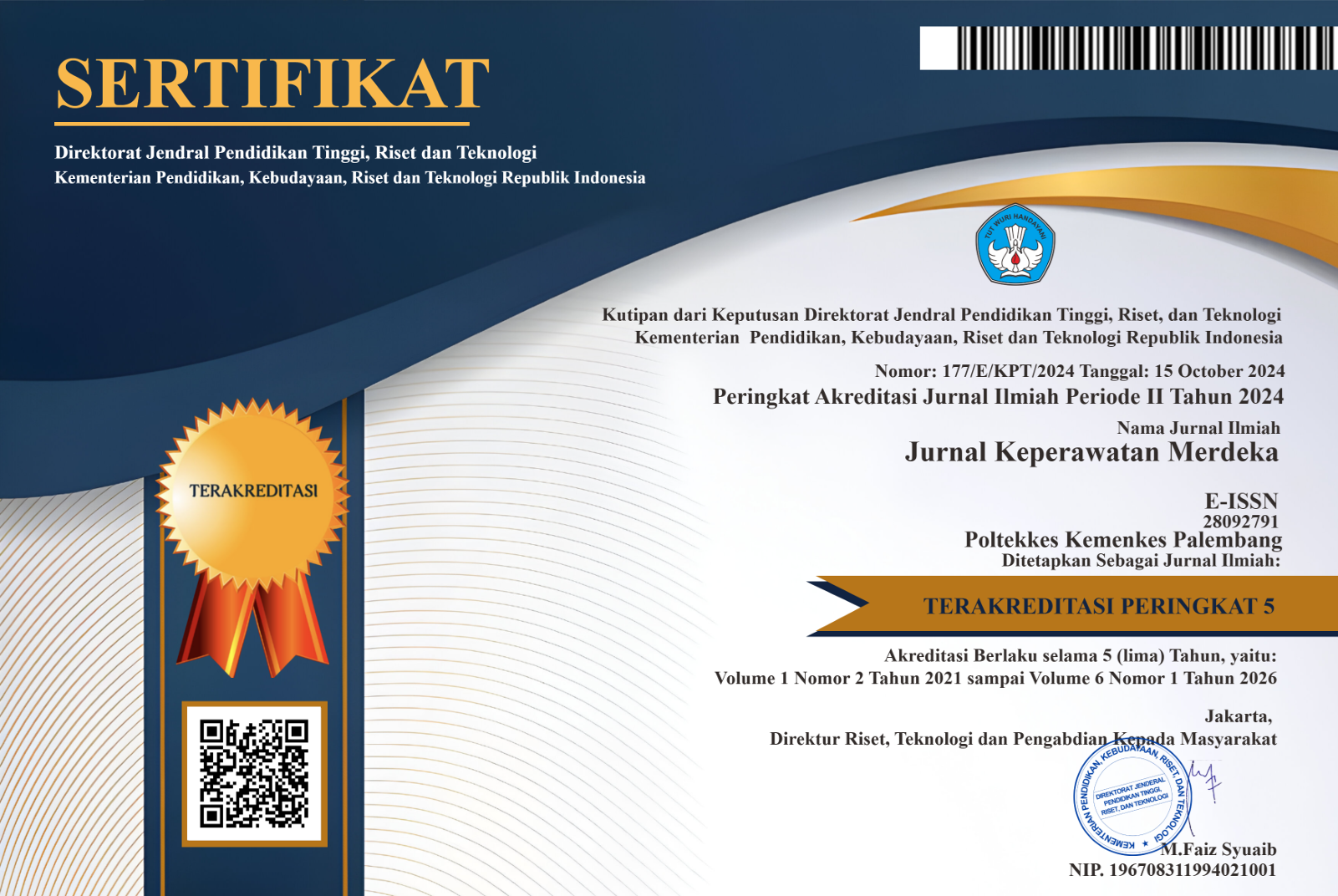Efektivitas Edukasi Perawatan Kaki Melalui Edu Home Care Terhadap Kemampuan Perawatan Kaki Klien Diabetes Melitus
Abstract
Latar Belakang: Penderita diabetes sangat berisiko terhadap adanya luka kaki, pada umumnya luka kronis dan sulit penyembuhannya. Hal ini disebabkan penderita DM rentan terkena infeksi yang erat hubungannya dengan pengembangan kuman pada lingkungan dengan kadar glukosa tinggi. Salah satu upaya penanganan atau pencegahan luka kaki diabetes yaitu dengan perawatan kaki yang mencakup tindakan mencuci kaki dengan benar, menggunakan alas kaki yang tepat, inspeksi kaki, dan senam kaki. Metode: Desain penelitian menggunakan Quasi experiment. Sampel diambil acak dari populasi klien diabetes militus sebanyak 35 orang kelompok eksperimen dan 40 orang kontrol . Kelompok eksperimen diberikan edukasi perawatan kaki melalui edu home care dan kelompok kontrol hanya diberi video. Kemampuan perawatan kaki pada kedua kelompok diamati melalui log book pada pre dan post test. Analisis data penelitian ini menggunakan uji t paired test dan independent t test. Hasil: Penelitian ini menghasilkan edukasi perawatan kaki dengan edu home care efektif meningkatkan kemampuan perawatan kaki pada pengurus dan anggota majelis taklim BKMT OKU. Bila edukasi dilakukan dengan suasana belajar yang relaks maka kemampuan perawatan kaki akan meningkat. Kesimpulan: Edukasi perawatan kaki melalui edu home care berpengaruh terhadap kemampuan perawatan kaki klien diabetes mellitus di kota Baturaja.
References
Arifin, H., Chou, K.-R., Ibrahim, K., Fitri, S. U. R., Pradipta, R. O., Rias, Y. A., Sitorus, N., Wiratama, B. S., Setiawan, A., Setyowati, S., Kuswanto, H., Mediarti, D., Rosnani, R., Sulistini, R., & Pahria, T. (2022). Analysis of Modifiable, Non-Modifiable, and Physiological Risk Factors of Non-Communicable Diseases in Indonesia: Evidence from the 2018 Indonesian Basic Health Research. Journal of Multidisciplinary Healthcare, Volume 15, 2203–2221. https://doi.org/10.2147/jmdh.s382191
Akbar, M. A. (2019). Buku Ajar Konsep-Konsep Dasar Dalam Keperawatan Komunitas. Yogyakarta: Deepublish.
Akbar, M. A., Malini, H., & Afiyanti, E. (2018). Progressive Muscle Relaxation (PMR) Is Effectice To Lower Blood Glucose Levels of Patiens With Type 2 Diabetes Mellitus. Jurnal keperawatan Soedirman, 13(2), 22-88. doi:10.20884/1.jks.2018.13.2.808
American Diabetes Association. (2021). Microvascular Complications and Foot Care: Standards of Medical Care in Diabetes-2021. Diabetes Care, 44(Suppl 1), S151-s167. doi:10.2337/dc21-S011
Desalu, O. O., Salawu, F. K., Jimoh, A. K., Adekoya, A. O., Busari, O. A., & Olokoba, A. B. (2011). Diabetic foot care: self reported knowledge and practice among patients attending three tertiary hospital in Nigeria. Ghana Med J, 45(2), 60-65. doi:10.4314/gmj.v45i2.68930
Fahmiyah, I., & Latra, I. N. (2016). Faktor Yang Memengaruhi Kadar Gula Darah Puasa Pasien Diabetes Mellitus Tipe 2 di Poli Diabetes RSUD Dr. Soetomo Surabaya Menggunakan Regresi Probit Biner. Jurnal Sains Dan Seni ITS, 5(2), 2337-3520.
Kementerian Kesehatan RI. (2019a). Epidemiologi dan Kebijakan Pengendalian Diabetes Mellitus di Indonesia. Jakarta: Direktur Pencegahan dan Pengendalian Penyakit Tidak Menular.
Kementerian Kesehatan RI. (2019b). Hasil Utama Riskesdas 2018. Jakarta: Badan Penelitian dan Pengembangan Kesehatan Kementerian Kesehatan RI.
Liu, Y., Zhou, S., Gao, Y., & Zhai, Y. (2019). Electrospun nanofibers as a wound dressing for treating diabetic foot ulcer. Asian Journal of Pharmaceutical Sciences, 14(2), 130-143. doi:10.1016/j.ajps.2018.04.004
Mariam, T. G., Alemayehu, A., Tesfaye, E., Mequannt, W., Temesgen, K., Yetwale, F., & Limenih, M. A. (2017). Prevalence of Diabetic Foot Ulcer and Associated Factors among Adult Diabetic Patients Who Attend the Diabetic Follow-Up Clinic at the University of Gondar Referral Hospital, North West Ethiopia, 2016: Institutional-Based Cross-Sectional Study. J Diabetes Res, 2017, 2879249. doi:10.1155/2017/2879249
McDowell, J., & Boyd, E. (2018). Community diabetes nurse specialists: service evaluation to describe their professional role. Br J Community Nurs, 23(9), 426-434. doi:10.12968/bjcn.2018.23.9.426
Mediarti, D., Rosnani, R., & Arifin, H. (2020). Summary Guidance for Daily Practices on Glycemic Control and Foot Care Behavior. Jurnal Ners, 15(2), 142. https://doi.org/10.20473/jn.v15i2.21127
Nikitara, M., Constantinou, C. S., Andreou, E., & Diomidous, M. (2019). The Role of Nurses and the Facilitators and Barriers in Diabetes Care: A Mixed Methods Systematic Literature Review. Behavioral sciences (Basel, Switzerland), 9(6), 61. doi:10.3390/bs9060061
Pennafort, V. P., Queiroz, M. V., Nascimento, L. C., & Guedes, M. V. (2016). Network and social support in family care of children with diabetes. Rev Bras Enferm, 69(5), 912-919. doi:10.1590/0034-7167-2015-0085
Pourkazemi, A., Ghanbari, A., Khojamli, M., Balo, H., Hemmati, H., Jafaryparvar, Z., & Motamed, B. (2020). Diabetic foot care: knowledge and practice. BMC Endocr Disord, 20(1), 40. doi:10.1186/s12902-020-0512-y
Puryanti, E., & Gustina, E. (2022). Analisis Faktor Risiko Kejadian Hipertensi di Puskesmas Lubuk Batang Wilayah Kerja Dinas Kesehatan Kabupaten OKU Tahun 2021. Jurnal Kesehatan Saelmakers PERDANA (JKSP), 5(1), 40-51.
Sari, C. W. M., Haroen, H., & Nursiswati, N. (2016). Pengaruh program edukasi perawatan kaki berbasis keluarga terhadap perilaku perawatan kaki pada pasien diabetes melitus tipe 2. Jurnal Keperawatan Padjadjaran, 4(3), 305-315. doi:10.24198/jkp.v4i3.293
Sujati, N. K., Erlika, Y., & Akbar, M. A. (2022). Penerapan Teknik Moist Balance Pada Asuhan Keperawatan Luka Kaki Diabetes. Lentera Perawat, 3(1), 22-30.
Sulistini, R., Mediarti, D., & Sitorus, N. (2022). The Health State of Patients with Diabetes During The Covid-19 Transition Period. JOSING: Journal of Nursing and Health, 3, 1. https://doi.org/10.31539/josing.v3i1.4701
Copyright (c) 2022 JKM : Jurnal Keperawatan Merdeka

This work is licensed under a Creative Commons Attribution-ShareAlike 4.0 International License.
Authors who publish with this journal agree to the following terms:
- Authors retain copyright and grant the journal right of first publication with the work simultaneously licensed under a Creative Commons Attribution License that allows others to share the work with an acknowledgement of the work's authorship and initial publication in this journal.
- Authors are able to enter into separate, additional contractual arrangements for the non-exclusive distribution of the journal's published version of the work (e.g., post it to an institutional repository or publish it in a book), with an acknowledgement of its initial publication in this journal.
- Authors are permitted and encouraged to post their work online (e.g., in institutional repositories or on their website) prior to and during the submission process, as it can lead to productive exchanges, as well as earlier and greater citation of published work













